Restorative Practice
Restorative Practice and Justice
Mission: To advocate for racial equity by ensuring each child has equitable access to educational opportunities, in a learning environment where students feel safe, and secure and where their concerns are being heard and addressed.
What is Restorative Justice?
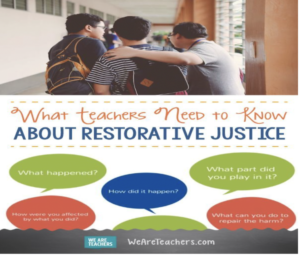 “Restorative Practices are based on the principles and processes that emphasize the importance of positive relationships as central to building community and restoring
“Restorative Practices are based on the principles and processes that emphasize the importance of positive relationships as central to building community and restoring
relationships when harm has occurred.” (SF Unified SchoolDistrict) Restorative Practice is about relationships; building, maintaining, and repairing relationships to form healthy, supportive, and inclusive communities. When we do things that
impact others and create harm in the community, it is our individual and collective responsibility to make things right. Restorative practices help create spaces that hold us accountable in supportive and inclusive ways.
It is important to note that at times, the terms Restorative Practice and Restorative Justice are used interchangeably. However, they do not have the same meaning. Restorative Practices describe a continuum of supports and strategies that
are proactive and responsive, while Restorative Justice is typically applied when harm has occurred in the community.
Click on the buttons below for more info
Why is Restorative Practice/Justice needed?
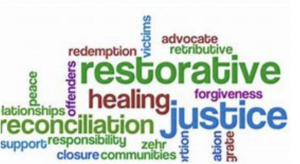
The national rethinking of disciplinary practices in American public schools continues. Reports from school districts across the country, anecdotal stories, investigative reporting, and scholarly research have illuminated the point that classroom exclusions, suspensions, and expulsions more often than not
fall on the backs of Black and brown children, leaving them in the shadows with disproportionate results, poor outcomes, and inequity in education.
Scholarly research and investigation have repeatedly shown that severe penalties are often meted out to children of color. Lost Opportunities: How Disparate School Discipline Continues to Drive Differences in the Opportunity to Learn, a
2020 report by the UCLA Civil Rights Project, provides a nationwide, state-by-state comprehensive analysis of the instruction days lost due to out-of-school suspensions in 2015- 16 for middle and high school students.
The report amplified that harsh disciplinary practices do not make schools more conducive to learning, help improve student behavior, get at the root causes of a student’s behavior, or make schools safer. The study shows that harsh, zero-tolerance type practices do make it harder for students to
stay engaged and connected to school; interrupts their learning, which can lead to declining grades and dropping out of the school; erodes a student’s sense of self, making them feel undervalued, stigmatized, or invisible; and makes it more difficult for teachers and administrators to exercise discretion and to use the type of behavioral interventions and restorative practices that could keep children otherwise engaged and connected to the school.
Rethinking school discipline is imperative. Finding new ways to reflect on the nature of the discipline, to challenge the inevitable discriminatory biases that arise, to be accountable for determining when children are or should be subjected to
discipline, and new, effective approaches to discipline, is vital. “The schools . . . need to get away from the “I” and get back to the “we” of caring, incorporate the concept of family . . . and “we’re here to support you” to our students. We need to do
problem-solving – not being sent home. Work with the students. To hear back from them – “you talked to us – you were thoughtful and reasonable.” That builds trust and accountability.
– former SPS elementary school instructor with 30-plus years of working directly with students and their families
Click on the links below for more info
Strategy
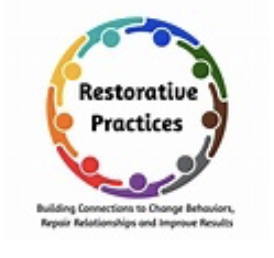
- Establish a community coalition to support the SPS Restorative Practice
Program. Solicit individual and organizations members to become a part of the
Restorative Practice “Community” Coalition (RPCC) - Establish a subcommittee of RPCC Members to help with supporting and
giving advice to the SPS Restorative Practice Program when requested. - Evaluate and give support to SPS Restorative Practice projects when requested or when an opportunity has been identified.
- Leverage partnerships and relationships within the community coalition to remove walls and silos so opportunities to collaborate on their “existing” racial equity programs for students can be identified.
- Create a Youth Coalition within the RPCC, to ensure their voice is heard
and to ensure we are getting current and ground-level input on the impact of the SPS Restorative Practice programs and initiatives. - Hold periodic meetings with the Seattle School Board, Seattle School Superintendent, and Seattle City officials to keep them in the loop and to maintain their support.
- Appear before the Seattle School Board and or the City Council etc., when
an opportunity and need exist for the voice of the RPCC needs to be heard - Work with RARE on ways to raise funds to support the SPS Restorative
Program’s projects. - Work with the RARE Marketing and Communication Committee to develop a RARE Restorative Practice webpage and media package, to provide information to interested parties on what is RJ/RP, why it is important, and how it benefits students, parents, teachers, and the community. The webpage would other allow individuals to sign up for the coalition, find out about future meetings, and ask questions.
- Work with the RARE Finance Committee on funding of SPS projects, applying for grants, and soliciting donations for the RPCC.
Why Do Disparities for Black and Brown Students
Exist?
What Are the Results of Disproportionate
Discipline for Students of Color?
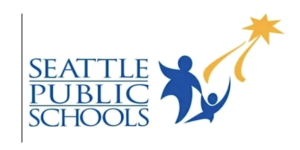 When students don’t have access to the full range of
When students don’t have access to the full range of
opportunities in their schools, they may become less engaged,
less connected to their school communities. And that’s without the additional experiences of racial discrimination and harsh penalties. When students are disengaged, feel unwelcomed, and not included in their school, they are more likely to do poorly and fall behind, and less likely to have their best possible school experience.
Of course, not every child who feels disengaged from school is going to be a discipline problem. But for those who end up on the wrong side of disciplinary action, it can lead to unfortunate, long-term consequences, including higher school dropout rates, being pushed into the school-to-prison pipeline, facing
challenges for attending college, becoming further distanced from obtaining good jobs with decent wages and having fewer skills to navigate the complexities of modern society. Academic gaps, inconsistent discipline policies, and disproportionate application of punitive measures added to an already fraught landscape for all students which lands most heavily on children of color.
The Seattle Public Schools Acknowledges That It
Has a History of Inequitable Discipline and
Educational Outcomes for Students of Color
Discipline disparities in education between students of color and white students have been known to the Seattle school district for decades. For more than half a century, the Seattle
Public Schools has struggled to find ways to interrupt patterns of harm it recognizes but continues to perpetuate.
In 1986, recommendations from a task force caused the school district superintendent to place a moratorium on suspensions and expulsions in elementary schools to support the abolition of the academic and discipline gap between Black and white students in Seattle schools. However, a 1996 follow-up found
that little progress had been made.
In 2002, the Seattle School District again acknowledged its poor progress in closing the disproportionate discipline rates and academic gaps for Black and White children.
In May 2013, the U.S. Department of Education Office of Civil Rights, on its own motion, began investigating the high rate at which Black students were disciplined in the Seattle Public Schools; SPS data showed that Black students were punished
more frequently and more severely than White students.
In the 2011-2012 school year, for instance, nearly 13% of Black high school students received at least one short-term suspension, while the equivalent figure for White students was just under 4% percent – more than three times the rate for Black students compared to White students. SPS data also found that more
than a quarter of Black middle schoolers had received short-term suspensions every year since 1996, the year the 1986 moratorium had been reviewed. Inequities for other students of color were also found. The then Superintendent of Schools
Jose Banda admitted, “I think we have a serious problem here… We do. We acknowledge that. We acknowledge the fact that the data is clear that there is a disproportionate number of students of color being suspended and expelled.”
In December 2020, investigations highlighting the discriminatory treatment of a Black student at a virtually all-white elementary school again illuminated SPS’ continued failure to comprehensively address its long-standing disproportionate discipline and academic gaps. Seattle Public Schools declares that it “is committed to furthering cultural intelligence that respects and values diversity across the district in schools and in classrooms. This commitment serves to influence decisions in promoting fair and equitable treatment for all and eliminating racial predictability and disproportionality in all aspects of education and its
administration.”
Click on the links below for more info
Foundations Of Restorative Justice
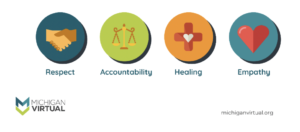
Results: Use of Restorative Justice and Restorative Practices at School: A Systematic Literature Review
https://www.ncbi.nlm.nih.gov/pmc/articles/PMC8751228/
3.2.3. Health Risk Behaviors
Four studies [24,25,26,28] highlighted the effects of restorative justice and restorative practices on health risk. It emerged that the use of the restorative approach at school reduces the likelihood of students engaging in harmful behaviors for health such as the use of substances, alcohol and drugs, smoking, and dangerous sexual intercourse.
3.2.5. Interpersonal Relationships
The two studies by Gregory et al. [38,39] highlighted a greater positive relationship between students and teachers following the high level of implementation of restorative practices by teachers, also affecting the relationship with students of different ethnicities, lowering the level of inequality and promoting equity and social justice, as well as raising the level of perception of teachers as more respectful.
3.2.6. Disparities
Eight studies [27,37,38,40,41,44,47,50] highlighted how restorative practices and even more the restorative approach to the whole school, by building positive interpersonal relationships, can contribute to lowering the level of racial, cultural, gender, and socioeconomic status inequality and exclusion, facilitating positive relationships between students and between students and teachers regardless of the “diversity of the other”.
3.2.7. School Climate and Safety
The restorative approach is one of the tools that can be considered and used by school staff to encourage the development and promotion of a positive school climate. Indeed, in 17 studies, significant changes in school climate and school safety emerged in schools that promoted the restorative approach. These studies found that in schools that promote restorative practices and, even more so, restorative justice as a school policy, there is a perception by teachers and students at a better school climate and an equitable environment, safe, supportive, inclusive and, more generally, of an improved school environment
3.2.8. Academic Outcomes and Absenteeism
Four studies [28,37,50,56] showed positive results in schools that had implemented the restorative approach and practices with respect to academic outcomes. Consequently, it emerged that higher school performance can contribute to lowering levels of school absenteeism [28,37,50,56]. Restorative practices as an alternative school disciplinary model can also lead to positive results with respect to academic outcomes with higher student engagement in education, supporting educational approaches to improve school performance, and absenteeism at school.
